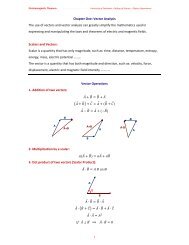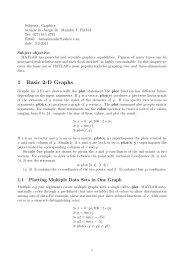Grammatical Aspect in English and Kurdish - University of Sulaimani
Grammatical Aspect in English and Kurdish - University of Sulaimani
Grammatical Aspect in English and Kurdish - University of Sulaimani
Create successful ePaper yourself
Turn your PDF publications into a flip-book with our unique Google optimized e-Paper software.
<strong>Grammatical</strong> aspect is represented differently <strong>in</strong> different languages.<br />
For <strong>in</strong>stance, <strong>in</strong> some languages, it is realized by prefixes, suffixes or other<br />
categories <strong>of</strong> the verb. There are different views concern<strong>in</strong>g the number <strong>of</strong><br />
the type <strong>of</strong> grammatical aspect <strong>in</strong> <strong>English</strong>. Some grammarians<br />
dist<strong>in</strong>guished two ma<strong>in</strong> types <strong>of</strong> aspect, for example, Comrie classifies<br />
grammatical aspect <strong>in</strong>to two ma<strong>in</strong> types: perfective <strong>and</strong> imperfective; the<br />
former <strong>in</strong>dicates the situations <strong>of</strong> short duration while the latter <strong>in</strong>dicates<br />
the situations <strong>of</strong> long duration (1976:16). While others draw a dist<strong>in</strong>ction<br />
between four types <strong>of</strong> grammatical aspect, these are: simple, perfect,<br />
progressive <strong>and</strong> perfect progressive aspect. For <strong>in</strong>stance, Celce-Murcia<br />
<strong>and</strong> Larsen-Freeman (1999:112-118) dist<strong>in</strong>guish four types <strong>of</strong> grammatical<br />
aspect <strong>in</strong> <strong>English</strong>:<br />
a. Simple aspect: it refers to events that are viewed as complete wholes.<br />
(3) a. Natalia helps her mother.<br />
b. Natalia helped her mother.<br />
b. Perfect aspect: the core mean<strong>in</strong>g <strong>of</strong> this type <strong>of</strong> aspect is “prior” which<br />
is used <strong>in</strong> relation to some other po<strong>in</strong>t <strong>in</strong> time, for example:<br />
(4) a. Natalia has helped her mother.<br />
b. Natalia had helped her mother when the guest arrived.<br />
c. Progressive aspect: the core mean<strong>in</strong>g <strong>of</strong> this type <strong>of</strong> aspect is<br />
imperfective which represents an event <strong>in</strong> such a way that allows for it to<br />
be <strong>in</strong>complete or somehow limited.<br />
(5) a. Natalia is help<strong>in</strong>g her mother.<br />
b. Natalia was help<strong>in</strong>g her mother.<br />
d. Perfect progressive aspect: the term suggests that this aspect comb<strong>in</strong>es<br />
the sense <strong>of</strong> “prior’ <strong>of</strong> the perfect with the mean<strong>in</strong>g <strong>of</strong> “<strong>in</strong>completeness”<br />
<strong>in</strong>herent <strong>in</strong> the progressive aspect.<br />
(6) a. Natalia has been help<strong>in</strong>g her mother for two hours.<br />
b. Natalia had been help<strong>in</strong>g her mother that year.<br />
It is necessary to mention that each <strong>of</strong> these pairs is identical <strong>in</strong> aspect but<br />
different <strong>in</strong> tense.<br />
In <strong>English</strong>, two ma<strong>in</strong> types <strong>of</strong> aspects can be realized: marked <strong>and</strong><br />
unmarked. There are three grammatically marked aspects <strong>in</strong> <strong>English</strong> which<br />
<strong>in</strong>dicate those aspects that are realized by <strong>in</strong>flectional morphemes that are<br />
determ<strong>in</strong>ed by perfect <strong>and</strong> progressive <strong>and</strong> perfect progressive aspects, for<br />
example: (7) a. He is play<strong>in</strong>g well<br />
b. He has played well.<br />
c. He has been play<strong>in</strong>g for two hours.<br />
In (7a), the aspect is marked by (be + -<strong>in</strong>g), while <strong>in</strong> (7b) it is<br />
marked by (have + PP) <strong>and</strong> <strong>in</strong> (7c) by (have + been + <strong>in</strong>g) which is a<br />
comb<strong>in</strong>ation <strong>of</strong> the perfect <strong>and</strong> progressive aspects. So it can be considered<br />
as a marked aspect as well. It is worth mention<strong>in</strong>g that the third type <strong>of</strong><br />
marked aspect is not regarded as a marked aspect because it is a<br />
comb<strong>in</strong>ation <strong>of</strong> perfect <strong>and</strong> progressive aspects. Whereas the unmarked<br />
aspect refers to those types <strong>of</strong> aspect which are not realized by any markers<br />
which are determ<strong>in</strong>ed by simple aspect, for example:<br />
(8) a. He plays tennis well.<br />
23<br />
BÑoÐG+/--6Òg?i@Ô+%/2&Ïg@½e+ÑÁ@¾â̺kÒÙÁ?iÒg@¡Ù}

















